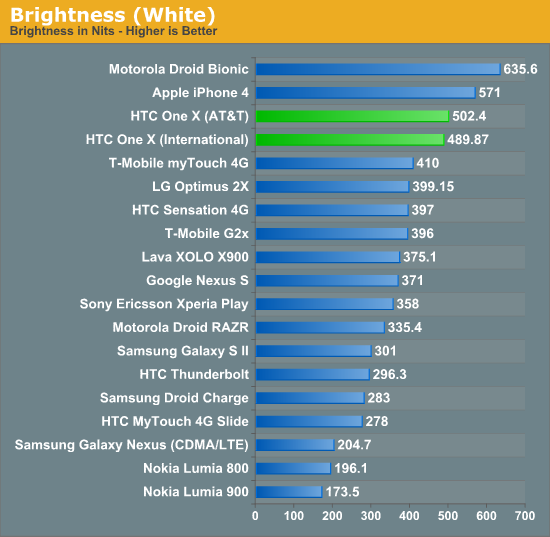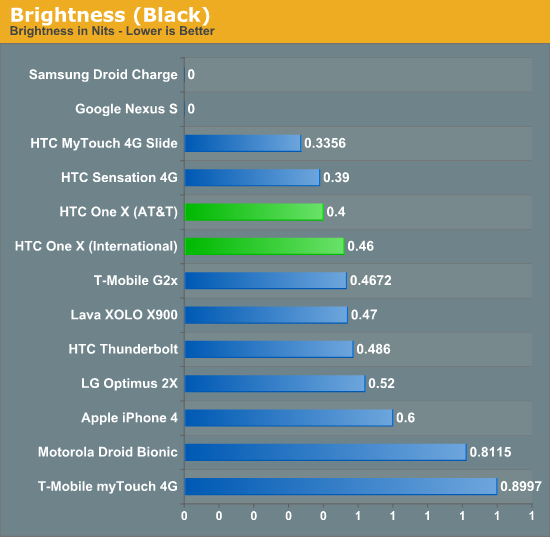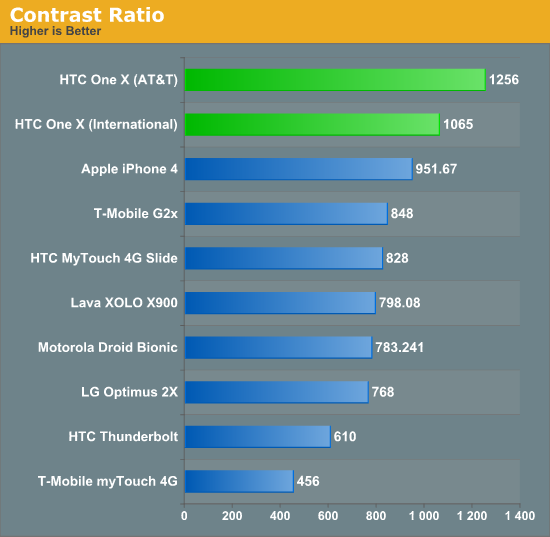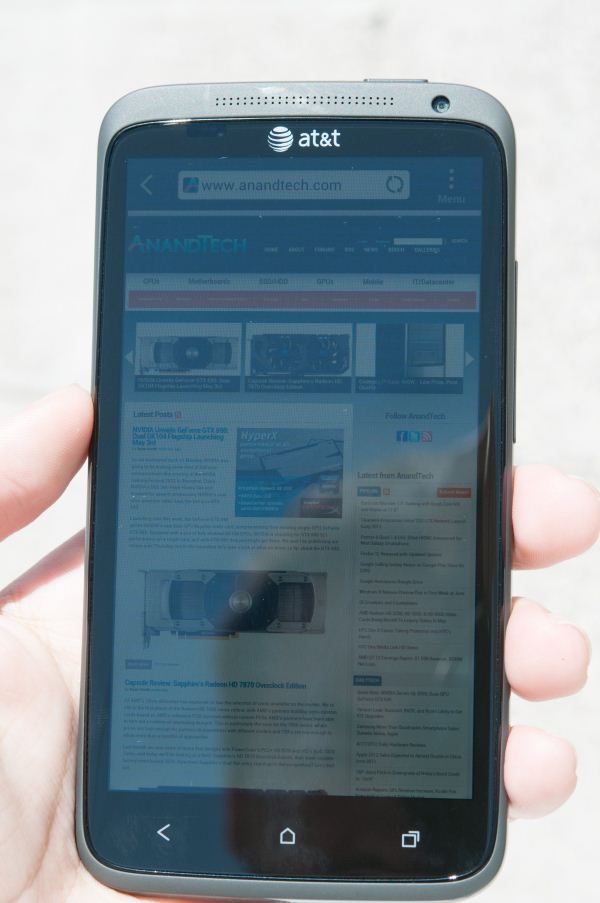The HTC One X for AT&T Review
by Brian Klug on May 1, 2012 6:00 PM EST- Posted in
- Smartphones
- Snapdragon
- HTC
- Qualcomm
- MSM8960
- Krait
- Mobile
- Tegra 3
- HTC One
- NVIDIA
The One X has a 4.7“ 1280x720 display that’s beautiful, dubbed the ”infinity screen.“ In fact, that’s really all you need to know about it - it’s absolutely wonderful, and honestly if you’re concerned with mobile displays just stop right there. At above 4.5” diagonal, 720p seems to be the new norm, and the combination of that 4.7" diagonal size and 720p on the HTC One X results in a PPI of 312. HTC shipped a device with an LCD display last year whose pixel density exceeded the iPhone 4/4S Retina Display for the first time in the HTC Rezound, which was 341 PPI.
Nevertheless the HTC One X still has subpixels small enough that I can’t visually distinguish them at all but from the most extreme distances. In addition, because it’s LCD you get an RGB stripe as opposed to PenTile RGBG like what currently ships on Samsung’s SAMOLED HD displays at 720p in the Galaxy Nexus.
I did some poking around, and my HTC One X (AT&T) review unit has a Sony display:
[DISP] mipi_video_sony_hd720p_init: assign initial setting for SONY_NT id 0x18103 Cut1, PANEL type = PANEL_ID_ELITE_SONY_NT



The panel goes extremely bright, at over 500 nits maximum, and has top of the chart contrast. As always I characterized the One X display using a combination of ColorHCFR and an i1D2 and Francois’ excellent Voodoo Screen Test Pattern generator application.
I’ve made both the color.chc file and measures available. The CIE diagram shows that HTC’s Infinity Display has very close to sRGB coverage, however color temperature is on the red side at just under 6000K. That’s really my only gripe, and curiously enough the One S with SAMOLED qHD displays are closer to 6500K than the LCD packing HTC One Xes.
Viewing angles look good on the HTC One X, there's no visible color shift at extreme angles. Outdoor viewing is also pretty good on the HTC One X, thanks in part to optical bonding between the display glass and LCD itself. One fewer air gap means fewer Fresnel reflections which quickly turn a display into a mess outdoors.
























137 Comments
View All Comments
Talcite - Tuesday, May 1, 2012 - link
On the display page, you said the SAMOLED+ has an RGBG subpixel. It should be changed to SAMOLED. The + variety has the regular RGB subpixel.Brian Klug - Tuesday, May 1, 2012 - link
Fixed, thanks!-Brian
metafor - Tuesday, May 1, 2012 - link
Will there be a T-Mobile One-S review? I noticed there's data here on it but I'm kinda shocked at how different the battery life is, considering it's a 1600mAH battery vs a 1800.Does AMOLED on the One-S really eat up that much power?
Brian Klug - Tuesday, May 1, 2012 - link
There will be a review of:• One S T-Mobile
• One S International
• One X International
Sometime next week :)
ImSpartacus - Tuesday, May 1, 2012 - link
Each device individually? You guys rock!bigboxes - Wednesday, May 2, 2012 - link
Will there be a HTC EVO 4G LTE review? You should include Sprint's variant as well.dagamer34 - Tuesday, May 1, 2012 - link
AMOLED eats up a lot of power because of the tendency of webpages to be white, which sucks up a lot of power compared to black.metafor - Tuesday, May 1, 2012 - link
Yes but I didn't expect that much. The difference between the battery life here is startling. The One X lasts 4 hours -- or 66% -- longer than the One S despite having a larger screen with more pixels. The battery difference alone can't explain that.Rivensteel - Tuesday, May 1, 2012 - link
I'm not certain that's correct. If you have an LED illumination you can locally dim your backlighting, but I don't think I've heard of that in mobile devices. If there's no local dimming, then theoretically black should be more power-intensive since you have to activate the LCD to block light transmission.NeoteriX - Wednesday, May 2, 2012 - link
1) No local dimming LEDs on mobile devices; it comes with high thickness since the lighting can't from the side, but must come from a backlighting array.2) Yes, black in theory does require power consumption from the LCD to block transmission, but from what I've seen, it's marginal compared to the powerdraw of the backlight itself, wireless antenna, SoC, etc. such that it's moot.